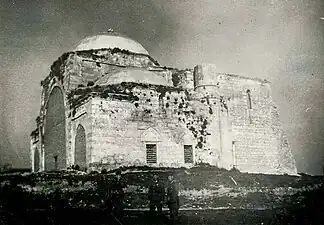| Iskender Bey Mosque | |
|---|---|
 The mosque today | |
| Religion | |
| Affiliation | Sunni Islam |
| District | Pella |
| Region | Central Macedonia |
| Ecclesiastical or organizational status | closed |
| Location | |
| Location | Giannitsa, Greece |
| Municipality | Giannitsa |
| State | Greece |
 Shown within Greece | |
| Geographic coordinates | 40°47′01″N 22°24′38″E / 40.78361°N 22.41056°E |
| Architecture | |
| Founder | Iskender Bey |
| Completed | 1510-1511 |
| Specifications | |
| Dome(s) | 2 (destroyed) |
| Minaret(s) | 1 (destroyed) |
| Materials | Brick, stone |
The Iskender Bey Mosque (Greek: Τζαμί του Ισκεντέρ Μπέη, from Turkish: İskender Bey Camii) is a historical Ottoman mosque in the town of Giannitsa, in Central Macedonia (northern Greece). It was built in the early sixteenth century by İskender Bey Evrenosoğlu, after whom it was named, who was the grandson of Gazi Evrenos, the founder of Giannitsa. Today the mosque stands in very poor condition and is in need of restoration. It is not accessible to the public. It is one of the three surviving Ottoman mosques in Giannitsa today.
History
The mosque was probably built between 1481 and 1512, most likely closer to the later date, and was commissioned by the grandson of Gazi Evrenos, one Iskender Bey Evrenosoğlu.[1] It was also called the Büyük Mosque (meaning large).[2] It has been suggested that Iskender Bey renovated a mosque that had already been built by his grandfather.[3]
When Turkish traveller Evliya Çelebi visited Giannitsa in the seventeenth century he described it as the "most well-developed, arranged, furnished, beautiful" building in the town, visited by many people.[4][3]
It was heavily damaged by bombing during the First Balkan War in 1911–12. Following the annexation of Giannitsa and the wider Macedonia region by the Kingdom of Greece in 1912 it was sold by the National Bank to individuals, and used as a warehouse until 1950, and then as a cotton factory.[5] In 1974 and again in 2000, the mosque was declared a cultural monument.[6] An expropriation process by the Ministry of Culture has been underway since the end of 2021.[7]
Architecture
It was built in the middle of the bazaar; Evliya Çelebi describes it as a praying mosque with a lead-covered dome.[4] The typical ceramic roof tiles of Byzantine architecture, was also employed in many Ottoman monuments in Greece, the mosque of Iskender Bey among them.[8] The mosque is built in eywan style, characterized by the central hall and the prayer hall eywan.[9] Iskender Bey Mosque is one of the two mosques in Greece of this style, the other being the Alaca Imaret Mosque in Thessaloniki.[9] The mosque has side rooms that are covered with two large semi-domes connected to the central dome along the same axis to form one oblong space; it is a unique feature which is not found elsewhere in Ottoman architecture.[9]
It has a five-bay portico, the most common type (along with the three-bay one) for Ottoman mosques in Greece.[10] The dome, when it still stood, was fourteen metres in diameter.[11] Both its interior and its exterior have undergone many alterations as a result of the mosque's various uses of the recent years, while its central dome has collapsed.[5] Of the minaret only the base survives; it stood at least as late as the 1930s as evidenced from old documents. Nothing survives of the old fountain and cemetery.[5]
Iskender Bey Mosque was described by professor Machiel Kiel as "a highly original building of a type we do not find anywhere else in the vast dominations of Ottoman architecture."[12]
Gallery
- Iskender Bey Mosque
 1916-1918 postcard of the mosque.
1916-1918 postcard of the mosque. Iskender Bey Mosque around 1941-1944
Iskender Bey Mosque around 1941-1944
See also
References
- ↑ Ameen 2017, p. 22.
- ↑ Cangül, Caner (July 25, 2023). "Evrenosoğlu İskender Bey Camii" [Mosque of Iskender Bey Evrenosoglu]. kulturenvanteri.com (in Turkish). Retrieved November 19, 2023.
- 1 2 Skiadaresis 2012, pp. 1–2.
- 1 2 Çelebi, Evliya (1972). Travelogue (in Bulgarian). Sofia, Bulgaria: OF Publishing House. p. 207.
- 1 2 3 Stavridopoulos 2015, pp. 195–196.
- ↑ Greek Ministry of Culture 28-7-2000
- ↑ Athens Voice Team (March 16, 2022). "Τρία σημαντικά μνημεία της Πέλλας ξαναβρίσκουν τη λάμψη τους" [Three important monuments of Pella are regaining their shine]. athensvoice.gr (in Greek). Retrieved November 19, 2023.
- ↑ Ameen 2017, pp. 209–210.
- 1 2 3 Ameen 2017, p. 234.
- ↑ Ameen 2017, p. 238.
- ↑ Ameen 2017, p. 243.
- ↑ Ameen 2017, p. 227.
Bibliography
- Ameen, Ahmed (2017). Islamic architecture in Greece: Mosques. Alexandria, Egypt: Center for Islamic Civilization studies, Bibliotheca Alexandrina.
- Skiadaresis, Georgios (2012). The Ottoman monuments of Giannitsa. Ephorate of Antiquities of Pella.
- Stavridopoulos, Ioannis (2015). Μνημεία του άλλου: η διαχείριση της οθωμανικής πολιτιστική κληρονομιάς της Μακεδονίας από το 1912 έως σήμερα [Other People's Monuments: the Management of the Ottoman Cultural Heritage of Macedonia from 1912 to the present] (Thesis) (in Greek). Ioannina: University of Ioannina.

